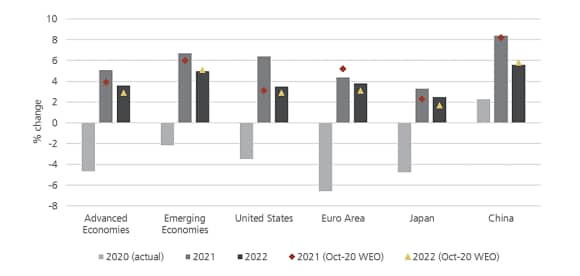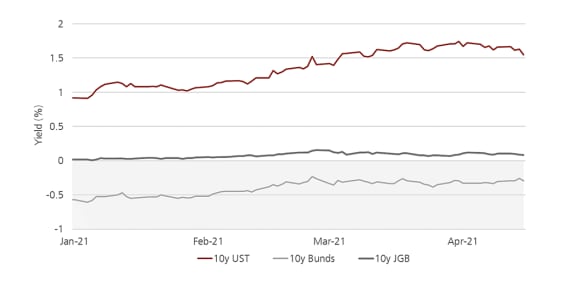Bond Bites A new rhythm?
What does the improved global growth outlook mean for developed market bond yields?

New York. 1924: A young George Gershwin is asked to write new music for a concert in honor of Abraham Lincoln’s birthday. Already proven as a talented composer he nonetheless tries something rather ambitious; to fuse the grand-scale emotion of European orchestral music of the Late Romantic Era, with the rhythmic vibrancy and syncopation of the emerging jazz styles of 1920’s America. On the opening night, fully embracing the jazz ethos, Gershwin even improvises some piano solos in his new work. Parts of the score are simply blank, and the orchestra, in front of a packed house, waits nervously for Gershwin’s signal for when to resume playing each time.
So became Rhapsody in Blue. Written in a matter of weeks, partly improvised on the night and blending styles that were literally worlds apart. Few could have imagined the importance of the piece at the time. Yet the resulting score became one of the most famous and popular pieces of music written in the past 100 years or more – those opening bars perhaps the most recognized in music of any era1.
The piece was perfectly in tune with the emerging spirit of the 1920s. The optimism and prosperity of Belle Époque Europe had been crushed in the catastrophe of the First World War, and the later flu pandemic that killed millions. But by the early 1920’s a new force was emerging as America gained dominance in global finance and capital. A few months after Gershwin unveiled his masterpiece, the US-led Dawes Plan was signed, and it was American capital that enabled Germany to resume payment of war reparations. The subsequent global capital flows helped fuel rapid economic growth and rising consumer spending in the Western world.
The Belle Époque was over, but the Jazz Age had arrived.
Is it too soon to hope we might be through our own collective trauma? The IMF (International Monetary Fund) is certainly getting more optimistic and, in its recent outlook, upgraded global growth projections for 2021 and 2022 to reflect the accelerating vaccine roll-outs and widespread fiscal and monetary support. Their estimate of the contraction in 2020 was also smaller than previously thought. See chart 1.
Chart 1: IMF World Economic Outlook output projections
Chart 1: IMF World Economic Outlook output projections

Credit where it's due; this recovery has been composed by policy-makers' (and scientists’) own flashes of creativity and improvisation. The US is leading the fiscal response, with the American Rescue Plan Act adding another USD 1.9 trillion of economic stimulus to the USD 900 billion for COVID-19 relief, already agreed at the end of the last administration. The combined USD 2.8 trillion of spending in 2021 certainly looks more impressive than the EUR 750 billion in grants and loans agreed under the European Union's Next Generation EU plan that extends into 20262.
So this will not be the first time the US has played a key role in a cyclical global recovery story, and bond markets have been quick to price the better outlook there. But caution is required before seeing a straightforward repeat of the 'Roaring Twenties' that some commentators have predicted. Countries dance to different tunes.
Chart 2 contrasts the recent increase in US Government 10-year yields with those in Germany and Japan. Although all yields have moved higher, the difference partly reflects the more relaxed attitude from the Federal Reserve.
Chart 2: US, German and Japanese sovereign bond yields - 2021 year-to-date
Chart 2: US, German and Japanese sovereign bond yields - 2021 year-to-date

In contrast, the European Central (ECB) faces a much weaker economy, where the vaccine rollout has been bumpier and the fiscal response more tepid. Things will probably improve but for the time being the ECB has been forced to recommit to its existing stimulus program to fend off an unwanted tightening in financial conditions.
This creates some interesting opportunities; with 10-year Bunds yielding -0.3% in Euros, European investors look enviously at US Treasuries yielding 1.7% in US dollars. Table 1 shows US 10-year yields today, and that same yield but with the US dollar currency risk hedged into different currencies around the world. In fact, it highlights that for investors in low-yielding regions such as the Eurozone and Japan, owning US dollar bonds hedged back to respective local currency offers a better prospective return today than equivalent local currency bonds of a similar maturity.
Table 1: Currency hedged 10-year Government yields
Investor domicile | Investor domicile | Local Govt. 10y | Local Govt. 10y | UST 10y (hedged to local currency) | UST 10y (hedged to local currency) |
|---|---|---|---|---|---|
Investor domicile | USA | Local Govt. 10y | 1.67% | UST 10y (hedged to local currency) | 1.67% |
Investor domicile | Euro Area | Local Govt. 10y | -0.30%* | UST 10y (hedged to local currency) | 1.07% |
Investor domicile | Japan | Local Govt. 10y | 0.10% | UST 10y (hedged to local currency) | 1.21% |
*10y Bund yield. Source: UBS Asset Management, Bloomberg, data as of 12 April 2021. Currency hedge calculated as implied return from 3-month (annualized) FX forwards. Past performance is not a guide to future results.
This fact could prevent a relentless march higher in US yields. In a world of divergent recoveries from the pandemic, differing central bank policy responses but highly mobile savings, demand from savers in low-yielding Eurozone and Japan could act as a brake on a path of higher yields in countries like the US, even if the recovery continues.
Another factor that may constrain yields in future is that real growth rates might simply be more 'yawning' than 'roaring'. My colleague Kevin Zhao Head of Global Sovereign and Currency has completed some interesting analysis using the most recent IMF forecasts mentioned above. He used their forecasts for the major economies for 2020-2026 and compared these with the realized growth levels for each of the preceding decades. The results are summarized in Table 2 but his point is that, based on IMF data, average growth rates from 2020-2026 will be lower than in each of the preceding four decades. Even the US, with that huge stimulus, averages just 1.79%, well below the levels of the late 1990's. Clearly, in the IMF's view, developed economies will be facing the challenges posed by low aggregate demand for many years to come.
Table 2: Annual real GDP growth rates (average)
Investor Domicile | Investor Domicile | 1980-89 | 1980-89 | 1990-99 | 1990-99 | 2000-09 | 2000-09 | 2010-19 | 2010-19 | 2020-26 (f) | 2020-26 (f) |
|---|---|---|---|---|---|---|---|---|---|---|---|
Investor Domicile | United States | 1980-89 | 3.12% | 1990-99 | 3.22% | 2000-09 | 1.91% | 2010-19 | 2.30% | 2020-26 (f) | 1.79% |
Investor Domicile | Canada | 1980-89 | 2.87% | 1990-99 | 2.38% | 2000-09 | 2.09% | 2010-19 | 2.22% | 2020-26 (f) | 1.55% |
Investor Domicile | Australia | 1980-89 | 3.46% | 1990-99 | 3.26% | 2000-09 | 3.14% | 2010-19 | 2.60% | 2020-26 (f) | 2.04% |
Investor Domicile | Germany | 1980-89 | 1.87% | 1990-99 | 2.21% | 2000-09 | 0.77% | 2010-19 | 1.93% | 2020-26 (f) | 1.06% |
Investor Domicile | France | 1980-89 | 2.37% | 1990-99 | 2.02% | 2000-09 | 1.46% | 2010-19 | 1.38% | 2020-26 (f) | 1.09% |
Investor Domicile | Italy | 1980-89 | 2.34% | 1990-99 | 1.46% | 2000-09 | 0.54% | 2010-19 | 0.26% | 2020-26 (f) | 0.43% |
Investor Domicile | United Kingdom | 1980-89 | 2.66% | 1990-99 | 2.34% | 2000-09 | 1.76% | 2010-19 | 1.83% | 2020-26 (f) | 1.03% |
These are exactly the crosscurrents that bond investors must navigate today; on the one hand a gigantic wave of US-led stimulus that may lead to a period of higher growth and inflation, pushing bond yields ever higher. Or a world where these effects are offset by massive global capital flows that anchor yields in some markets and a continuation of structural factors that keep real growth rates low.
Nobody can know for sure how these forces will play out – it's why we advocate a flexible approach to managing fixed income portfolios today, and one that can adapt to the ebb-and-flow of powerful cyclical and structural forces.
For more information about our current thinking please click here.
